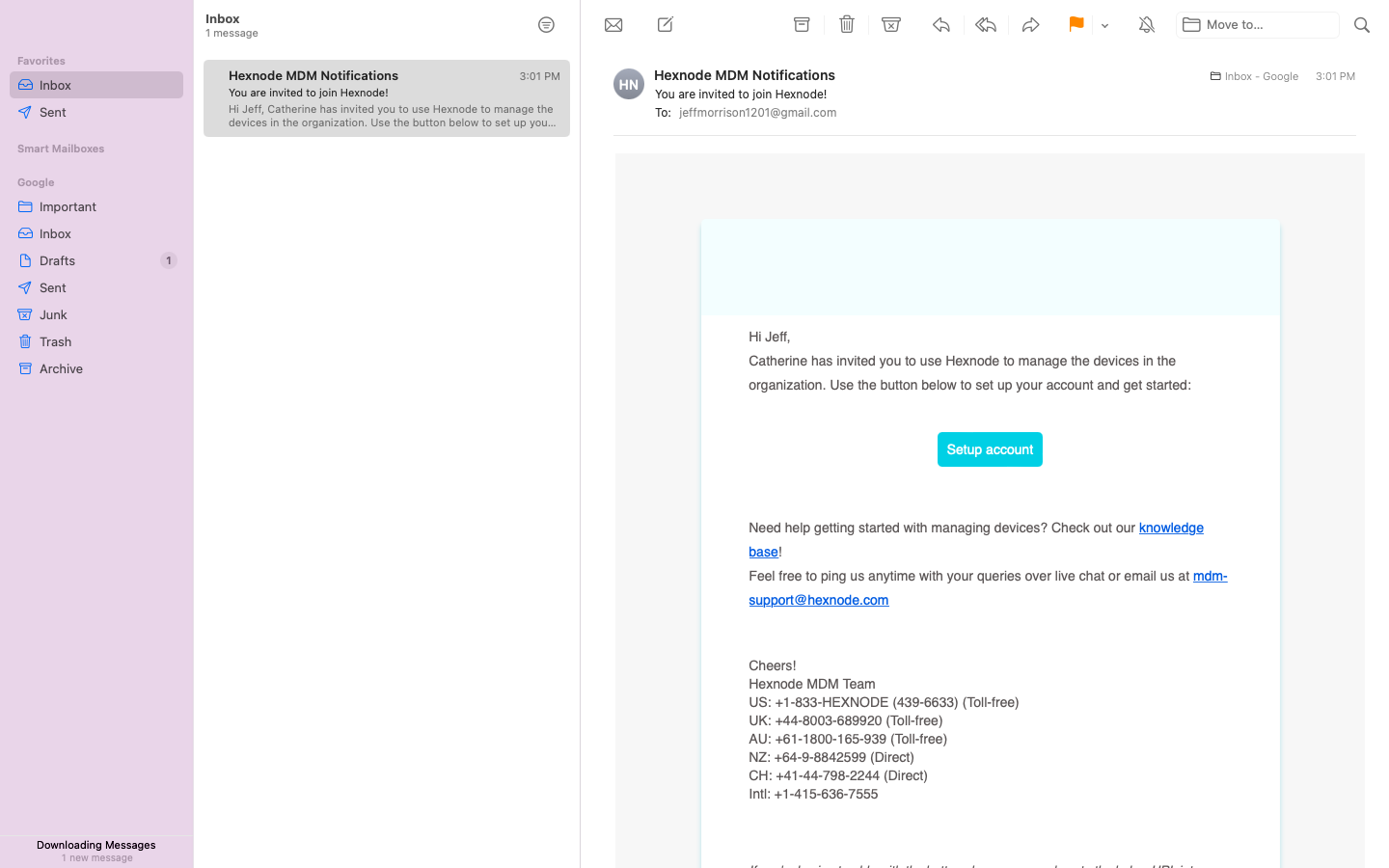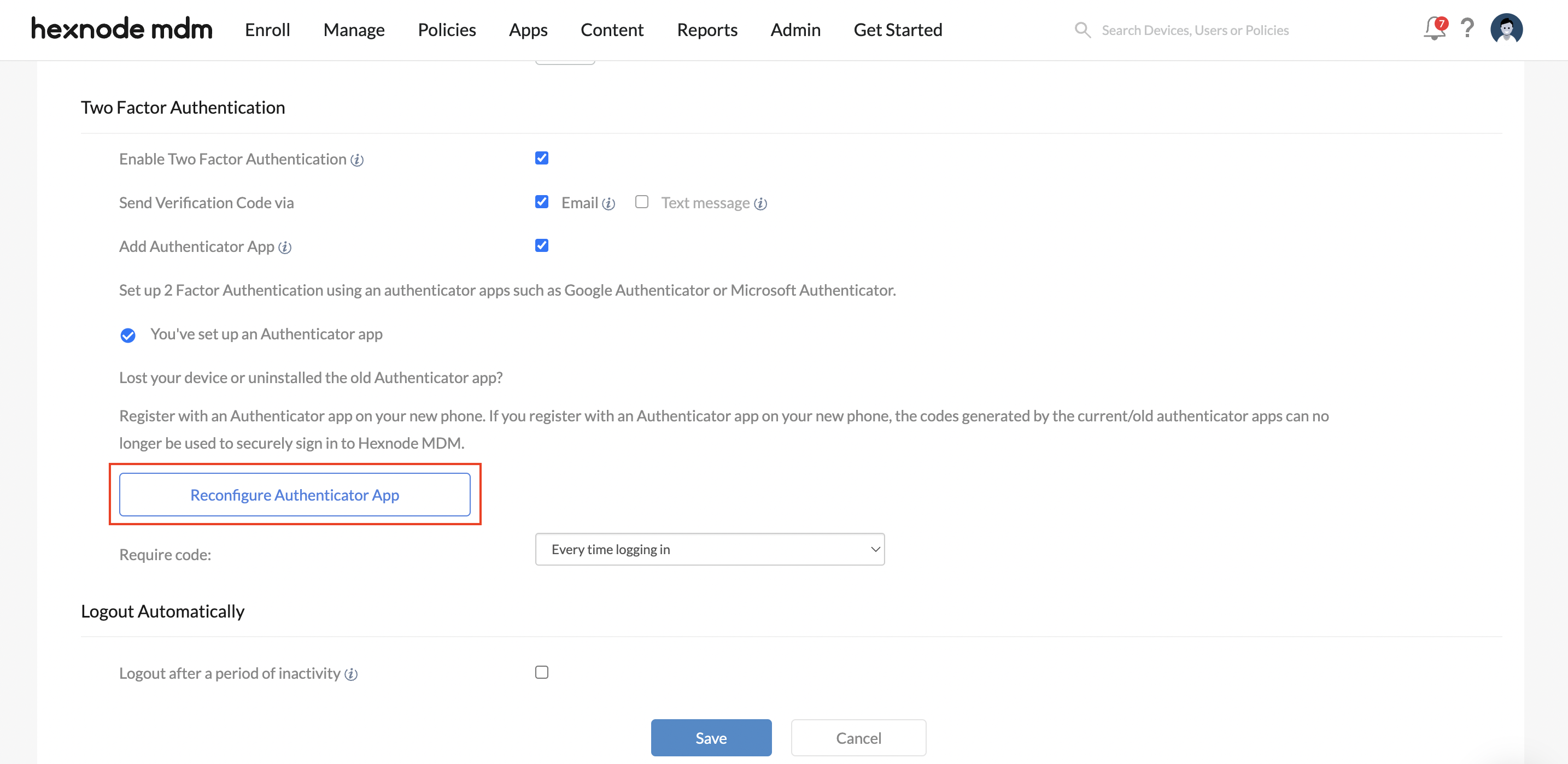Category filter
Configuring Technicians and Roles in Hexnode
Hexnode UEM encompasses the basic to the most advanced device management functionalities under a single console to help administrators during their course of action. Just like how it takes on a different approach to device administration combined with user management, Hexnode also helps organizations distinctly manage the users on Hexnode who administer the devices. Device administrators operating on the Hexnode console are referred to as technicians, and you can have the console managed by multiple technicians.
The technician who signs up for the portal is the Super Admin, who can then create other technicians. As new technicians are created, they can also be assigned any roles based on their scope of operation. The role assigned to a technician determines the functionalities on the portal that they can access. Three roles are available by default – Admin, Reports Manager, or Apps and Reports Manager.
- Admin: Admins have full privileges and access to all the features in the portal.
- Reports Manager: Reports managers can access only the dashboard, Reports tab and the features there.
- Apps and Reports Manager: Apps and Reports managers have access to the features in both the Apps and Reports tabs. They can also view the dashboard.
More roles can be defined depending on how the technicians should work with the Hexnode portal.
Create technicians in Hexnode UEM
To create a technician,
- On your Hexnode console, navigate to Admin > Technicians and Roles.
- Click on Add Technician.
- Under the Details section, you can configure the following account information and settings:
Account Information
- Enter the first and last name of the technician.
- Enter the Username/Email of the technician. If you are enabling SSO (Single Sign-On) for the technician, the username should match the user’s email address.
- Enter the Phone number of the technician.
- Specify the name of the organization where the technician belongs.
Single Sign On- If required, enable SSO login via Google, Microsoft, or Okta for the technician. Technician sign-in with local credentials is enabled by default.
CAPTCHA- Verify with CAPTCHA after ___ failed login attempts: Choose the maximum failed login attempts for a technician, after which CAPTCHA will be enabled. It can take values between 1 and 10. By default, the set value is three.
Two Factor AuthenticationThe second authentication factor for technician login into Hexnode can be a time-based email/SMS OTP or a verification code generated by a third-party authenticator app. For example, the technician can employ Microsoft Authenticator or Google Authenticator as the third-party app that provides a verification code for safe login. You can configure the two-factor authentication settings for a technician from the portal.
- Mandate Two Factor Authentication: Enabling this option would initiate login via a two-step verification process. The first step involves the technician signing in with a local or directory password. The second step is to enter a verification code sent to the technician or provided by third-party authenticator apps. This option is enabled by default.
- Send Verification Code via: Select Email or Text message as the method. The technician will receive the verification code for signing in based on it.
- Ask this user to set up Third Party Authenticator: If enabled, the technician can only sign in to their portal by verifying the time-based code shown in the Microsoft Authenticator or Google Authenticator app. You can even log in via the recovery codes if you do not have access to the third-party app on the device. Recovery codes are obtained while setting up the third-party authenticator app. Note that a recovery code can only be used once to log in.
- Require code: Choose the period after which the two-factor authentication will be mandated for technician sign in. The available options are Every time logging in, Every 7 days, and Every 30 days.
Logout Automatically- Logout after a period of inactivity: If enabled, the technician will get logged out after the specified period of inactivity.
- Logout after: Set the time for the period of inactivity, after which the technicians will get logged out automatically. The available options are 30 min, 45 min, 60 min, 90 min, 2 hours, 4 hours, and 8 hours.
- Click Next.
- The role-based settings for the given technician can be configured in the Role sub-section.
- Click on the Assign Role button. Three roles are available by default – Admin, Reports Manager, or Apps and Reports Manager.
- You can also assign a custom role to a technician and define its scope. However, custom role technicians cannot access actions that impact critical modules like deletion of APNs, Android Enterprise configuration etc.
- Click Assign.
- Click Save.
Setting up Technician Account
Creating a technician account will send an email invitation link to the given email ID. The link will automatically expire in a day or if it is used once. The technicians can activate the account by clicking on the Setup account in the email invitation.

Next, the technician will be asked to set up a local password for the account or sign in with Google, Microsoft, or Okta (when SSO login is enabled).
The next step is to enable two-factor authentication. To set up the authenticator app for 2FA,
- Install the Google Authenticator or Microsoft Authenticator app on your device.
- Open the authenticator app on your device and scan the QR code shown or enter the code displayed on the login page.
- Navigate to your Hexnode portal and log in with the local/SSO account credentials.
- Enter the verification code generated by the app on the portal for successful app setup.
Edit Technician
An admin or super admin can log in to their technician account to edit the settings or information for themselves or other technicians.
- Go to Admin > Technicians and Roles.
- Click on the more icon and select Edit Technician corresponding to the technician you want to edit.
- Click on Edit Information on the My Profile page.
- Under the Details sections, you may edit the following settings: Account Information, Single Sign On, CAPTCHA, Two Factor Authentication and Logout Automatically.
- On the Roles sub-tab, you can assign a different role to the technician. You may also define the scope if you are assigning a custom-created role. Learn more on custom technician roles.
Resend account activation link
For an Admin or Super Admin to resend the account activation link of another technician,
- Go to Admin > Technicians.
- Click on the more icon and select Resend account activation link corresponding to the required user.
It will resend the activation link to the technician’s email account. This option will not be available once the technician sets up their Hexnode account.
Reset Password
If an Admin or Super Admin wants to reset the password of another technician,
- Go to Admin > Technicians.
- Click on the more icon and select Reset Password corresponding to the technician whose password you want to reset.
- Click on Proceed.
A password reset link will be sent to the technician at the specified email ID. The email will expire in a day. The technician has to set up a new password using this link to sign in. The technician will be blocked from logging in to the portal until he uses the password reset link to set up a new password.
Reset SSO
A super admin and an admin can reset his own or other technician’s SSO accounts using this option.
- Go to Admin > Technicians.
- Click on the more icon and select Reset SSO corresponding to the required technician.
- A confirmation dialog box stating that an email will be sent to the technicians to reset the SSO account will be displayed. Click on Yes.
- Complete the user authentication to confirm the process.
Deactivate Technician
A technician can be deactivated without removing their account from the portal. Likewise, an Admin can deactivate the account of other technicians except for a Super Admin. To deactivate a technician:
- Go to Admin > Technicians and Roles.
- Among the list of technicians, disable the toggle button corresponding to the technician whose account is to be deactivated.
- Complete user authentication to confirm the deactivation process.
A deactivated technician account can be activated by re-enabling the toggle button and completing the user authentication.
Delete Technician
If an admin or a super admin wants to delete a technician,
- Go to Admin > Technicians.
- Click on the more icon and select Delete Technician corresponding to the technician name.
- Click on Yes.
- Complete the user authentication and confirm the deletion process.
Limiting the number of technicians as per the pricing plan
The number of technicians that can be configured depends on the pricing plan you have subscribed to.
For the Pro plan,
- Two technicians are available by default.
- The primary technician is Super Admin, and the other technician is Admin. No other technician roles are available.
- More technicians can be purchased from the portal. They will be assigned the role of Admin.
- The CAPTCHA limit for failed technician login is set to the default value 3.
- Includes two-factor authentication for technician login.
For the Enterprise plan,
- Three technicians are included in this pricing plan.
- The primary technician is Super Admin. Other technicians, including the additional technicians purchased from the portal, can be assigned with any of the roles, Admin, Reports Manager or Apps and Reports Manager.
- The CAPTCHA limit for failed technician login can be customized.
- Includes two-factor authentication for technician login.
For the Ultimate plan,
- There are four technicians included by default.
- The primary technician is Super Admin. The other technicians, including the additional technicians purchased from the portal, can be assigned with any of the roles, Admin, Reports Manager or Apps and Reports Manager. Also, you could manage access to the various tabs on the Hexnode portal for a custom role assigned to a technician and define the access scope individually.
- The CAPTCHA limit for failed technician logins can be customized.
- Includes two-factor authentication for technician login.
- Technician SSO login using Google, Microsoft and Okta is also included.
For the Ultra plan,
- Five technicians are available by default.
- The primary technician is Super Admin. The other technicians, including the additional technicians purchased from the portal, can be assigned with any of the roles, Admin, Reports Manager or Apps and Reports Manager. Additionally, technicians can be assigned custom roles. You may also set granular level permissions for sub-tabs within each tab for a custom role assigned to a technician and define access scope.
- The CAPTCHA limit for failed technician logins can be customized.
- Includes two-factor authentication for technician login.
- Technician SSO login using Google, Microsoft and Okta is also included.
When the number of active technicians reaches the maximum limit allocated to each plan, you have to either deactivate or delete any active technicians or upgrade your pricing plan to add new technicians. You can also purchase additional technicians if and when required via the License tab in Admin. The cost for an additional technician is as follows:
- Annual subscription – $324/year per technician
- Monthly subscription – $30/month per technician



